
1st International Electronic Conference on Toxins
Part of the International Online Conferences on Toxins series
16–31 January 2021
Mechanism of action andor pathophysiology of toxins, Use of toxins as tools for research drug discovery and therapeutics, Impact of toxins on public health, Impact of toxins on agriculture, Evolution of toxins, Novel plant animal insect and microbial toxins
- Go to the Sessions
- Event Details
Awards Winners Announcement
We are pleased to announce the winners of different awards of IECT2021:
Best Paper Awards
Winner 1 |
Winner 2
|
|
Montamas Suntravat *, Oscar Sanchez, Armando Reyes, Abcde Cirilo, Jack S. Ocheltree, Jacob A. Galan, Emelyn Salazar, Peter Davies, Elda E. Sanchez |
The enteric nerve system as target of regulated and emerging food-associated mycotoxins. Michał Dąbrowski, Hamza Olleik, Amine Kadri, Valérie Camps, Philippe Pinton, Isabelle Oswald, Łukasz Zielonka, Marc Maresca * |
Best Poster Awards
Winner 1 |
Winner 2
|
|
Linear Scorpion Peptides: An unexplored pool for peptide hydrogels Constantinos Avraamides, Spiridoula Diavoli, Ariana Robertson, Manos Vlasiou, Elena Mourelatou, Christos Petrou, Yiannis Sarigiannis * |
Cyclodextrins as capture agents of lipophilic marine toxins Charlotta Wirén *, Maria Rambla-Alegre, Anna Safont, Carles Alcaraz, Jorge Diogène, Mabel Torréns, Alex Fragoso, Mònica Campàs * |
Best Oral Presentation Award
Webinar Title: Unique Approaches to Tackle Snakebite-Induced Deaths and Disabilities
Date: 25 January 2021
Winners: Dr. Sakthivel Vaiyapuri (Chair), Prof. Dr. José María Gutiérrez and Dr. Andreas Hougaard Laustsen.
Welcome Message
IECT 2021 Welcome Message from Prof. Dr. Jay W. Fox (conference chair)
Online Sessions Recordings
In this section, you will find the recordings of the Live Sessions to watch, re-watch and share with your colleagues!
Session 1 - 21 January 2021
Mycotoxins: Involvement in Fungal Plant Infection, Animal/Human Toxicity and Potential Therapeutic Applications
Session 2 - 22 January 2021
Mycotoxins: Involvement in Fungal Plant Infection, Animal/Human Toxicity and Potential Therapeutic Applications
Session 3 - 25 January 2021
Unique Approaches to Tackle Snakebite-Induced Deaths and Disabilities
Session 4 - 26 January 2021
Immunotoxin and Beyond - Past, Present and Future Perspectives
List of accepted submissions (57)
| Id | Title | Authors | Presentation Video | Poster PDF | |||||||||||||||||||||||||||||||||||||
|---|---|---|---|---|---|---|---|---|---|---|---|---|---|---|---|---|---|---|---|---|---|---|---|---|---|---|---|---|---|---|---|---|---|---|---|---|---|---|---|---|---|
| sciforum-039861 | Activation of anion channels in human cells after long term exposure to the marine toxin azaspiracid | , , , , , , | N/A |

|
Show Abstract |
||||||||||||||||||||||||||||||||||||
|
Azaspiracids (AZAs) comprise a group of marine toxins first documented in the Netherlands after ingestion of contaminated mussels, harvested in Ireland coasts, by the end of the last century [1-3]. Azaspiracids are known to be produced by dinoflagellates belonging to the genera Azadinium and Amphidoma [4]. In recent years, part of the research on marine toxins effects on human health have focused on their chronic effects. The presence of azaspiracid in fishery products has been regulated in Europe establishing a limit of 160 μg kg-1 AZA equivalents [5]. Since then, several acute in vitro studies were undertaken to elucidate their mechanism of action, but the results obtained showed great controversy regarding the possible cellular targets of AZAs that could contribute to the symptomatology elicited in humans after ingestion of contaminated fishery products. Our group has recently described that these toxins partially blocked sodium entry into the cells and caused cytoskeletal alterations [6], however the effect of these toxins on ion channels remains almost completely unexplored. Therefore, the main aim of our study was to gain more insight on the effects of azaspiracids on ionic homeostasis and cell volume regulation [7]. Thus, electrophysiological effects of nanomolar concentrations of azaspiracids (50 nM) after a 15-20 h exposition of human embryonic kidney cells (HEK293) which express the human Nav1.7 alpha subunit of the sodium channel were determined. Here, using electrophysiological techniques combined with several pharmacological approaches, we demonstrated that AZA-1 elicited a significant increase in anion efflux that could account for the pathophysiology observed in human intoxications. References
|
|||||||||||||||||||||||||||||||||||||||||
| sciforum-041132 | Functional characterization of a novel rCRiSP (recombinant cysteine-rich secretory protein) from Crotalus oreganus helleri | , , | N/A |

|
Show Abstract |
||||||||||||||||||||||||||||||||||||
|
Snake venom is a highly complex and diverse cocktail of different proteins and peptides that cause a wide range of biological disturbances in an envenomated victim. While many snake venom toxins have been comprehensively characterized, other toxins such as cysteine-rich secretory proteins (CRiSPs) remain largely unexplored. CRiSPs are ubiquitous non-enzymatic toxins found in many species of snakes worldwide. Several CRiSPs isolated from Asian and Australian snake venoms have been shown to inhibit ion channel/smooth muscle contraction. We have recently reported that Hellerin, a svCRiSP that we have isolated from the venom of the Southern Pacific Rattlesnake, C. oreganus helleri, directly increases vascular permeability in vivo and in vitro. These observations may be parallel to Bj-CRP’s local effects, a CRiSP isolated from the venom of Bothrops jararaca, that has been shown to induce profound inflammatory responses in local tissues through the recruitment of neutrophils and the production of IL-6. To shed new light on svCRiSPs’ molecular targets and inflammatory responses, a recombinant CRiSP from C. o. helleri (named rHellerin) was cloned and tested for vascular and cellular permeability and pro-inflammatory responses. rHellerin was able to induce vascular leakage in vivo and cellular permeability similar to that of native CRiSP. rHellerin was also able to induce increased production of the cytokines IL-8 and IL-6 in human blood and lymphatic endothelial cells. These findings can provide a straightforward method of obtaining biologically viable svCRiSPs identical to the native form, which can accelerate research into further understanding the molecular biology of svCRiSPs by elucidating functionally active residues and subsequent molecular targets/interactions. rHellerin can represent potential in the development of new therapeutic strategies to prevent death and disability from snakebite. |
|||||||||||||||||||||||||||||||||||||||||
| sciforum-041135 | Evaluation of in vitro muscle regeneration after myonecrosis induced by Bothrops alternatus and Bothrops diporus venoms from Northeastern Argentina | , , , | N/A | N/A |
Show Abstract |
||||||||||||||||||||||||||||||||||||
|
The majority of snakebites in northeastern Argentina are caused by Bothrops alternatus (yarará grande) and Bothrops diporus (yarará chica), reptiles that belong to the Viperidae family. The specific treatment of these ophidian envenomations is serotherapy with antivenoms that ensures a rapid distribution of antibodies and controls the systemic alterations but not always the local damage in the bite site where traces of venom are capable to preclude a successful regenerative response. In this work, we explore the characteristics of muscle tissue during the critical period after Bothrops alternatus or Bothrops diporus venom injection and their potential inhibitory effect on muscle differentiation using an in vitro study model. Groups of CF-1 mice were injected intramuscularly in the right gastrocnemius with 50 µg of B. alternatus or B. diporus venoms. Control mice received PBS under identical conditions. Briefly, animals were sacrificed after 0, 1, 3, 24 and 168 hours, muscles were dissected out and placed in liquid nitrogen for pulverization and filtration through 0.22 µm membranes. Venom proteins present in these homogenates were quantified by the ELISA method and analyzed by Western Blotting. Myoblast cells (C2C12 cell line) were exposed for 24h to muscle homogenates and the less cytotoxic ones were used for myogenesis evaluation. Results evidenced that the amount of both venoms in muscle homogenates decreased over time, with even traces of venom (5-13 µg/mL) being observed 168h after inoculations. No significant differences were detected between B. alternatus and B. diporus venom treatments. Identification by immunoblotting showed typical venom protein bands with molecular masses between 20 and 100 kDa for B. alternatus and 14 and 100 kDa for B. diporus whose intensities gradually decreased with time. An intense band of ~60 kDa, characteristic of metalloproteases, was mainly visualized even after 7 days of both treatments. In addition, less cytotoxic muscle homogenates (above 85% of myoblast viability corresponding to 24 and 168 h incubation times) were used for myogenesis assay. Control showed mature myotubes formation after 72h but a complete lack of myoblast fusion occurred when myogenic cells were incubated with muscle homogenates from mice injected with bothropic venoms. These preliminary findings suggest that a possible local treatment, complementary to serotherapy, could improve the prognosis of snakebite poisonings by accelerating muscle regeneration processes. |
|||||||||||||||||||||||||||||||||||||||||
| sciforum-041136 | Genetic responses and aflatoxin inhibition during interaction between aflatoxigenic and non-aflatoxigenic Aspergillus flavus | , , , , , , |
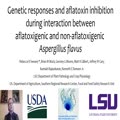
|
N/A |
Show Abstract |
||||||||||||||||||||||||||||||||||||
|
Aflatoxin is a carcinogenic mycotoxin produced by Aspergillus flavus in corn. Non-aflatoxigenic A. flavus isolates are applied to corn fields as a biocontrol to reduce aflatoxin contamination. Direct contact or touch between aflatoxigenic and non-aflatoxigenic isolates dramatically reduces aflatoxin production. To understand the mechanism of touch inhibition, a high-throughput RNA-seq study was conducted to examine gene expression during their interaction. Non-aflatoxigenic strain KD17 and aflatoxigenic strain KD53 were grown separately and in co-culture for 30 and 72 h. Toxin production was high in the aflatoxigenic monoculture and negligible in co-cultures. When grown separately, the toxigenic strain represented 7% and 33% of the combined biomass at 30 and 72 h, respectively. However, only 3% of the sequence reads uniquely aligned to the aflatoxigenic strain during co-culture, indicating growth and/or gene expression of the aflatoxigenic strain was inhibited in response to the non-aflatoxigenic strain. Few reads aligned to the aflatoxin gene cluster during co-culture. Eighteen genes expressed during mono-culture of the non-aflatoxigenic strain were further up-regulated during co-culture, indicating a response to contact. Of those genes, seven belong to a putative secondary metabolite cluster, suggesting a potentially inhibitory compound is produced. Taken together, these results suggest that non-aflatoxigenic strains inhibit growth and aflatoxin biosynthetic gene cluster expression in aflatoxin-producing strains. In addition, other secondary metabolite genes are upregulated during biocontrol interaction. This study demonstrates a potential role of inhibitory secondary metabolites in the biocontrol mechanism and deserves further exploration to improve biocontrol formulations. |
|||||||||||||||||||||||||||||||||||||||||
| sciforum-041140 | Exploration of the biological effects of a basic Phospholipase A2 from Agkistrodon piscivorus piscivorus venom | , , , , | N/A | N/A |
Show Abstract |
||||||||||||||||||||||||||||||||||||
|
Background: Phospholipases A2 (PLA2s) are found in abundance in many North American snake species. They are responsible for a wide array of pharmacological effects on tissues both locally and systemically. In A.p.piscivorus (A.p.p.), these toxins make up a significant portion of venom constituents. A basic PLA2 was recently isolated through reverse phase HPLC and identified as a D-49 PLA2 (A.p.p PLA2). After testing activities on an in vivo model, the release of pro-inflammatory mediators, systemic myotoxicity, and hemolytic effects were observed. This study aims to explore the hematological, myotoxic and pro-inflammatory activities of this toxin using in vitro models. Methods: Whole blood was used to test hemolytic activity of A.p.p PLA2 in vitro and, through the SONOCLOT analyzer, the effects on the hemostatic system. Moreover, we tested cell viability, expression of cell activation molecules, and cell damage markers on human umbilical vein endothelial cells (HUVEC) representing the vascular system and a myoblast cell line (C2C12) as a muscle model. Cells were incubated with A.p.p PLA2 over different times. Cell viability was tested using MTT assay, the expression and release of pro-inflammatory and hemostatic mediators were done using flow cytometry and ELISA. Muscle damage was detected evaluating creatine kinase (CK) release. Discussion/ Conclusion: It was observed that A.p.p PLA2 caused significant hemolytic activity and substantial changes in the coagulation system and mild changes in platelet function in whole human blood. Likewise, this toxin altered cell viability in C2C12 but not in HUVEC. Endothelial cells were also activated when incubated both at 3 h and 24 h. Additionally, C2C12 released IL-6 and CK, which are markers of cell damage. This data can be used for further experimentation to characterize enzymes belonging to this family to produce specialized antivenoms that target PLA2s and their biological activities. |
|||||||||||||||||||||||||||||||||||||||||
Live Online Session Programs
| Date & Time | Chair | Registration |
|
21 January 2021 1:00 - 3:00 pm (CET) |
Dr. Isabelle Oswald Dr. Marc Maresca |
|
|
22 January 2021 1:00 - 3:00 pm (CET) |
Dr. Laura Soler Vasco Dr. Veronika Nagl |
|
|
25 January 2021 1:00 - 3:00 pm (CET) |
Dr. Sakthivel Vaiyapuri | |
|
26 January 2021 2:00 - 4:10 pm (CET) |
Dr. Maria Serena Fabbrini Prof. Dr. Rodolfo Ippoliti |
For more information on the Special Issue linked to the Live Session, please click here. |
Schedule of 21 January
| Time | Speaker | Title |
|
1:00 – 1:05 pm |
Dr. Marc Maresca |
Welcome from the Chair |
|
1:05 – 1:40 pm (25 min presentation + 10 min Q&A) |
Prof. Dr. Fiona Doohan |
Wheat resistance to a fungal mycotoxin: Insights into the co-evolution of plants and their pathogens |
|
1:40 - 1:55 pm (10 min presentation + 5 min Q&A) |
Dr. Philippe Pinton |
Co-occurrence of DON and emerging mycotoxins in pig feed- Assessment of their combined intestinal toxicity |
|
1:55 – 2:30 pm (25 min presentation + 10 min Q&A) |
Dr. Veronika Nagl |
MicroRNAs as new markers for mycotoxin toxicity? The example of zearalenone in pigs |
|
2:30 -2:45 pm (10 min presentation + 5 min Q&A) |
Prof. Dr. Viviane Maruo |
Intestinal and hepatic toxicity of ergot alkaloids at doses close to EU regulatory limits |
|
2:45 – 3:00 pm (10 min presentation + 5 min Q&A) |
Dr. Laura Sole Vasco |
Versicolorin A and Aflatoxin B1: Like father, like son? |
Schedule of 22 January
| Time | Speaker | Title |
|
1:00 - 1:35 pm (25 min presentation + 10 min Q&A) |
Dr. Isabelle Oswald | Evaluation of mycotoxins: Principles and regulations |
|
1:35 - 2 :10 pm (25 min presentation + 10 min Q&A) |
Dr. Siska Croubels | Fate of major mycotoxins in pigs and poultry, and in growing piglets as surrogate model for children |
|
2:10 - 2:25 pm (10 min presentation + 5 min Q&A) |
Dr. Delphine Payros | The food contaminant deoxynivalenol exacerbates inflammatory bowel disease |
|
2:25 - 3:00 pm (25 min presentation + 10 min Q&A) |
Dr. Marc Maresca | Friends or foes? Toxicity and potential therapeutic applications of fungal cyclodepsipeptides |
Schedule of 25 January
| Time | Speaker | Title |
|
1:00 - 1:05 pm |
Dr. Sakthivel Vaiyapuri | Opening of Webinar by the Chair |
|
1:05 - 1:40 pm (30 min presentation + 5 min Q&A) |
Prof. Dr. José María Gutiérrez | Insights into the Mechanisms of Action of Snake Venom Hemorrhagic Metalloproteinases |
|
1:40 - 2:15 pm (30 min presentation + 5 min Q&A) |
Dr. Andreas Hougaard Laustsen | Experimental Approaches for Generating Broad-Spectrum Recombinant Antivenoms |
|
2:15 - 2:50 pm (30 min presentation + 5 min Q&A) |
Dr. Sakthivel Vaiyapuri | Venomous Snakebites: Rapid Action Saves Lives – A Community Education Programme to Increase Awareness about Snakes and Snakebites among the Rural Population of India |
|
2:50 - 3:00 pm |
Dr. Sakthivel Vaiyapuri | Closing of the webinar by the Chair |
Schedule of 26 January
For more information on the Special Issue linked to the Live Session, please click here.
| Time | Speaker | Title |
|
2:00 – 2:10 pm |
Dr. Maria Serena Fabbrini |
Welcome from the Chair |
|
2:10 – 2:35 pm |
Prof. Dr. Hendrik Fuchs |
Glycosylated Triterpenoids as Effective Enhancers of Immunotoxins |
|
2:35 - 2:55 pm |
Dr. Riccardo Vago |
Potential Applications of Saporin-Based Nanotherapeutics as Anti-cancer Agents |
|
2:55 - 3:15 pm |
Prof. Dr. David Flavell |
Dissection of Potential Mechanisms Driving Triterpenoid Saponin Augmentation of Immunotoxin Cytotoxicity |
|
3:15 – 3:35 pm |
Prof. Dr. Rodolfo Ippoliti |
Aptamer-Driven Toxin Gene Delivery in Glioblastoma |
|
3:35 – 4:00 pm |
Related Speakers |
Questions and Answers |
|
4:00 - 4:10 pm |
Dr. Maria Serena Fabbrini |
Closing of Webinar by the Chair |
Online Session Speakers
Speakers
Dr. Marc Maresca |
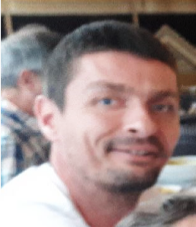 |
Marc Maresca is currently Researcher at the Aix-Marseille Université. He was awarded his PhD in Biochemistry from the Université Paul Cézanne (France, 2003), where he worked on toxins causing intestinal pathologies, including mycotoxins. In 2003, he moved to England to work on the enteropathogenic E. coli bacteria in the laboratory of Brendan Keny. He then moved back to France to continue his work on mycotoxins, mainly deoxynivalenol, studying its effects on human health. He is currently working at the Aix-Marseille Université, and his research aims, in addition to studying the effects of mycotoxins on health, to identify and develop new molecules—natural, synthetic, and bio-inspired, including those produced by micro-organisms—with antimicrobial properties.
|
Prof. Dr. Fiona Doohan |
 |
Prof. Dr. Doohan has a BSc in Industrial Microbiology from UCD (Ireland) and a PhD from John Innes Centre/Open University (UK). After a postdoctoral position at John Innes Centre, she moved to UCD, where she joined the faculty as a plant pathologist. Prof. Dr. Doohans’ recent research is focused on understanding the role of mycotoxins in plant–pathogen interactions and developing environmentally sustainable means of increasing crop sustainability. She is also co-founder of the company E-Seed, focused on developing biologicals for the enhancement of crop productivity. She is a member of the Scientific Board of the Global Wheat Initiative, a G20 initiative that promotes wheat research at the international level in both developed and developing countries.
|
Dr. Philippe Pinton |
 |
Dr. Philippe Pinton, PhD, Engineer, has worked for 20 years at INRA’s TOXALIM Research Centre in Food Toxicology (Toulouse, France), where he is a member of the Biosynthesis and Toxicity of Mycotoxins team. His field of expertise is the study of the effects of food/feed contaminants, mainly the mycotoxins, at low doses and in mixtures, using cellular and animal models.
|
Dr. Veronika Nagl |
 |
Veronika Nagl works as a Scientist at the BIOMIN Research Center in Tulln (Austria). Veronika studied Veterinary Medicine at the University of Veterinary Medicine, Vienna. Thereafter, she did her PhD in the Christian Doppler Laboratory for Mycotoxin Metabolism at the University of Natural Resources and Life Sciences, Vienna. Her research focused on the development of LC-MS/MS-based biomarker methods to elucidate the metabolism of masked mycotoxins in rats and pigs. After a postdoc period in the same lab, she joined the BIOMIN Research Center in Tulln (Austria) in 2014. There, her main research topic is the investigation of the molecular effects of Fusarium mycotoxins in livestock species. Special emphasis is put on employing -omics technologies and utilizing results for biomarker development.
|
Prof. Dr. Viviane Maruo |
 |
Dr. Maruo is Associate Professor of Veterinary Toxicology at the Federal University of Tocantins (UFT). She obtained her Veterinary Medicine degree at the University of São Paulo in 1993 and obtained her master's degree (1997), PhD (2002), and post-doctorate (2010) in the field of Experimental and Comparative Pathology at the University of São Paulo. She completed a CNPq-funded postdoctoral fellowship in 2015 at INRA's TOXALIM unit. She was in charge of the Graduate Program in Tropical Animal Science at UFT from 2010 to 2014. Currently, she has a CAPES-funded visiting professor fellowship at the TOXALIM INRAE unit, where she conducts research focusing on the toxicity of mycotoxins.
|
Dr. Laura Soler Vasco |
 |
Dr. Laura Soler Vasco was born in Spain, earned her Doctor of Veterinary Medicine degree at the University of Murcia (Spain), and completed postdocs at KU Leuven (Belgium) and INRAE Val de Loire (France) on pig intestinal pathophysiology and clinical proteomics. She has been a junior researcher at the Biosynthesis and Toxicity of Mycotoxins group at INRAE Toulouse since 2017. Her research interests center on applying systems biology approaches to reveal the toxicity of mycotoxins.
|
Dr. Isabelle Oswald |
 |
Dr. Isabelle Oswald is the head of INRA’s TOXALIM Research Center in Food Toxicology in Toulouse, France. In this Research Center, she leads a research team of 20 persons. This team has two main goals: (1) characterizing the production of mycotoxins and other secondary metabolites by fungal species and (2) determining the toxic effects of mycotoxins in rodents and pigs using cellular, tissular, and animal models. Dr. Oswald’s work currently focuses on the effect of emerging mycotoxins and toxin mixtures. She has more than 200 international publications and has been a Thomson Reuters/Clarivate Highly Cited Researcher since 2018. She is an expert for the European Food Safety Agency (EFSA), ANSES, and the Joint FAO/WHO Expert Committee on Food Additives (JEFCA). In 2018 she received a Lifetime Achievement Award from INRAE, and this January she was appointed Knight of the French Legion of Honor.
|
Dr. Siska Croubels |
 |
Siska Croubels graduated as Master in Pharmaceutical Sciences from Ghent University. After obtaining her PhD in the field of bio-analysis of veterinary drugs, she was a postdoc in the Faculty of Veterinary Medicine of UGent. In 2004, she was appointed as Assistant Professor of Veterinary Toxicology in the same faculty. Since 2014, she has been Full Professor and Director of the Department of Pharmacology, Toxicology and Biochemistry. Her research in the field of veterinary toxicology focuses on the toxicokinetics and toxicokinetic modeling of mycotoxins, the interactions between mycotoxins and pathogens in several animal species, and the development of in vitro and in vivo models for efficacy and safety testing of mycotoxin detoxifiers. Her research group is a member of the MYTOX and MYTOX-SOUTH association research platforms, dealing with the effects of mycotoxins on human and animal health in the North and South.
|
Dr. Delphine Payros |
 |
Dr. Delphine Payros, PhD, works at the Digestive Health Research Institute as a member of the Pathogenesis and Commensalism of Enterobacteria team, in strong collaboration with the Biosynthesis and Toxicity of Mycotoxins team from TOXALIM in Toulouse. Her field of expertise is the study of the effects of co-exposure of food contaminants, mainly the deoxynivalenol and bacterial toxins, on gastrointestinal physiopathology and antibiotic resistance using animal models.
|
Dr. Sakthivel Vaiyapuri |
 |
Dr. Sakthi Vaiyapuri is Associate Professor of Cardiovascular & Venom Pharmacology at the University of Reading, UK. He is also a Royal Society Leverhulme Trust Senior Research Fellow for his research on snakebite-induced muscle damage. Sakthi’s research is mainly focused on establishing the pharmacological actions of venom toxins in inducing various envenomation effects. Notably, the research in his group aims at understanding the differential effects of venoms on skeletal muscle and the impact of next-generation antivenoms in preventing/treating snakebite-induced muscle damage. Through a robust community education program, his team is improving public awareness about snakes and snakebites among the rural population of India. So far, they have educated over 7 million people about the dangers of snakebites and the appropriate actions that people should take following a snakebite in order to mitigate snakebite-induced deaths and disabilities.
|
Dr. Andreas Hougaard Laustsen |
 |
Associate Professor Andreas Hougaard Laustsen is Head of the Tropical Pharmacology Lab at the Technical University of Denmark and specializes in antibody discovery, toxinology, and snakebite antivenom. Andreas is a Fellow of the Young Academy of Denmark and the Young Academy of Europe and holds a PhD from the University of Copenhagen and an MScEng from the Technical University of Denmark. Andreas is also a co-founder of the biotech companies Biosyntia, VenomAb, Antag Therapeutics, Chromologics, VenomAid Diagnostics, and Bactolife. Within toxinology, Andreas is known for having developed the world’s first recombinant fully human antibodies against animal toxins, for studying black mamba venom, and for developing methodologies for the generation of recombinant antivenoms.
|
Prof. Dr. José María Gutiérrez |
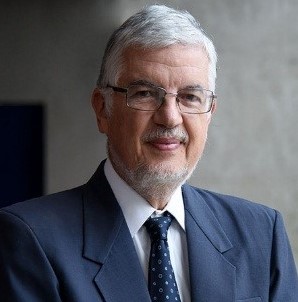 |
J.M. Gutiérrez is Emeritus Professor at Instituto Clodomiro Picado (ICP), School of Microbiology, University of Costa Rica, where he has taught courses in Immunology, Biochemistry, Cellular Pathology, and Research Methods. He has served as Director and Head of the Academic Division of ICP. His main research interests have focused on the biochemistry and mechanism of action of snake venoms and toxins, especially those responsible for the local pathological effects characteristic of viperid snakebite envenoming. He has also been involved in the development of antivenoms for various regions of the world and in the preclinical assessment of the neutralizing ability of antivenoms and novel inhibitory substances. He has participated in global advocacy efforts to raise the awareness of the impact of snakebite envenoming and in the network of Latin American laboratories which manufacture antivenoms. Prof Gutiérrez is a member of the Board of Directors of the Global Snakebite Initiative (GSI).
|
Dr. Maria Serena Fabbrini |
 |
Dr. Maria Serena Fabbrini is a passionate cell molecular biologist and Professor of Sciences and Mathematics for MIUR (ministero-istruzione-università e ricerca). She has a Ph.D. in Biological Sciences from the University of Milan. Part of her research experience was obtained while working in the plant biotechnology field at Istituto Biosintesi Vegetali of CNR (National Research Council). She also worked as a contractor for a pharmaceutical company (Farmitalia Carlo Erba), dissecting human endothelin processing using Xenopus oocyte expression system (1990–1991). She then moved to the Biotechnology unit in Dibit-HSR in 1992, before working in the “Protein Transport and Secretion unit” as a staff scientist to work on “cells as protein factories'' (2001–2004), where she mentored several students, including medical school students from the Unversità-Vita salute. She started mid-1990 exploring the use of the plant ribosome-inactivating protein saporin isoforms (please add) from Saponaria officinalis, as well as plant genes, for delivery against metastatic tumors. In 2005–2009, she participated as a PI in the Recombinant Immunotoxin Research Group (RICG), a collaborative project funded by Leukaemia Busters charity, in which she developed the use of Pichia pastoris as a eukaryotic host for hostile protein production, such as ligand toxins. She has gained great experience as Grant Scientific Manager, analyzing applications in human genetics during several Telethon calls, working for Telethon’s Scientific office, and was appointed as manager of the Scientific Affairs and Grant office at the Istituto Nazionale Genetica Molecolare (INGM’s scientific office) in 2011. She is mostly interested in human genetic diseases, targeting toxins for anticancer therapies, tumor microenvironment, and cell biology of novel antitumor natural agents. She has a record of publications both in plant cell biology/biotechnology and in cell biology, studying the entry route of saporin and anti-urokinase-based chimeric saporin fusions. She is co-author of more than 30 peer-reviewed publications in international journals indexed in the Scopus and ISI WEB databases.
|
Prof. Dr. Rodolfo Ippoliti |
 |
For more than 20 years, Prof. Dr. Rodolfo Ippoliti has been working in the field of protein structure and function, drug targeting, and generation of cytotoxic chimeras, with particular reference to the use of ribosome-inactivating proteins as toxic molecules. In recent years, his interest has been also focused on the production of antibody–drug conjugates (ADCs) for cancer treatment. He is also involved in other projects concerning the biotechnological use of recombinant proteins in tissue regeneration, as well as projects concerning drug design against parasitic infections. He has been Professor of Molecular Biology at the University of L’Aquila since 2008 and was formerly Associate Professor of Biochemistry at the same University (2000–2008). From 1990 to 2000, he worked at the University of Rome La Sapienza as a technician in the Laboratory of Molecular Biology, Faculty of Medicine. At the moment, he is a group leader at the same department specified above. He has published 87 peer-reviewed papers and several book chapters (h-index: 21 Scopus; 23 Google Scholar).
|
Prof. Dr. Hendrik Fuchs |
 |
For more than 15 years, Prof. Dr. Hendrik Fuchs has been working on the development of protein-based targeted antitumor drugs and new strategies to enhance endosomal escape. After finishing his Ph.D. work and a postdoc period, he became a group leader in 1997 at the Institute for Clinical Chemistry and Pathobiochemistry at the Benjamin Franklin University Hospital. After his habilitation in 2002, he continued his research as a Privatdozent and was appointed as Professor at the Institute for Laboratory Medicine, Clinical Chemistry and Pathobiochemistry at the Charité – Universitätsmedizin Berlin in 2010. He accepted a professorship for Target Cell Directed Tumor Therapy in 2014 at the same institute. He organized the 2nd, 4th, and 8th international Fabisch-Symposium for Cancer Research and Molecular Cell Biology on the topic of Targeted Tumor Therapies in 2006, 2009, and 2012. He is the coordinator of an EU project on targeted gene delivery funded with almost EUR 7 million and has successfully applied for more than 25 other projects. He has published more than 90 peer-reviewed articles with more than 250 impact points and 1500 citations; his h-index is 23.
|
Dr. Riccardo Vago |
 |
Dr. Riccardo Vago is Lecturer of Biochemistry at the Vita-Salute San Raffaele University and researcher at the San Raffaele Hospital, Milan, Italy. He holds a degree in Pharmaceutical Chemistry and Technology and obtained his Ph.D. in Genetic and Biomolecular Science from the University of Milan. He spent 2 years as a visiting research fellow in the UK and Switzerland, studying the intoxication route of ribosome-inactivating proteins and working on the employment of saporin protein/DNA as therapeutic agents. As a postdoctoral researcher and project leader in Pavia and Milano, he had the opportunity to investigate molecular mechanisms underlying complex diseases, such as cancer and neurodegeneration. The major research interests of his group currently include the elucidation of pathogenic molecular and cellular mechanisms leading to the tumor onset and progression with the aim to develop personalized medicine approaches for unmet clinical needs through the identification of new targets and the comprehension of disease fundamentals and heterogeneity. The design, production, and testing of recombinant chimeric proteins as fusions between toxins and peptides able to selectively recognize features typical of cancer cells and tumor microenvironment, as well as the development of toxin-carrying targeted delivery systems, fit into this pipeline. He is Principal Investigator and partner in several national and international research and innovation projects and author of more than 40 scientific publications in international journals indexed in the Scopus and ISI WEB databases with an h-index of 14 and over 770 citations.
|
Prof. Dr. David Flavell |
 |
Dr. David Flavell has been working in the field of cancer research for over 45 years. He obtained his first degree in Applied Biology from Liverpool John Moores University in 1975 before moving on to the University of Sheffield where he obtained his Ph.D. in cancer immunology in 1978. Following this, he obtained a Wellcome Trust Postdoctoral Fellowship to establish a laboratory at Siriraj Hospital (Mahidol University) in Bangkok to study the immunopathology of human liver fluke (Opisthorchis viverrini) infection and its aetiological role in human bile duct cancer. He transferred to the London School of Hygiene & Tropical Medicine (University of London) in 1979 to continue and progress this work until moving to the University of Southampton in 1984 to establish a laboratory in Professor Dennis Wright’s University Department of Pathology for the production of novel monoclonal antibodies for the diagnosis of leukaemia and lymphoma. Following the successful production of several useful diagnostic monoclonal antibodies, followed by a personal tragedy, David turned his attention in the early 1990s to repurposing his laboratory in Southampton to develop antibody-based treatments for the therapy of childhood and adult leukaemia and lymphoma. He and his wife, also an immunologist, established the charity Leukaemia Busters in 1992 to fund the development of Immunotoxins clinically to treat adult and paediatric patients with relapsed/refractory acute lymphoblastic leukaemia, B-cell lymphoma, and multiple myeloma. Preclinical work culminated in three separate phase I clinical trials in adults and children. David’s research interests now centre around methods to improve the therapeutic index of Immunotoxins to make them safer and yet more effective for treatment. In recent years this has involved exploring ways of exploiting the host innate immune system and devising methods to improve the endosomal escape of toxins in target cancer cells.
Welcome from the Chairs
Welcome to the 1st International Electronic Conference on Toxins
Dear scientists, researchers, and authors,
It is my unique pleasure to invite you to join the 1st International Electronic Conference on Toxins (IECT2021). This meeting will be hosted online by https://sciforum.net/conference/IECT2021 from 16 to 31 January, 2021.
For millennia, toxins have played an integral role in many aspects of human endeavors by impacting health and agriculture. In addition to detrimental roles, they have been incredibly useful in expanding our understanding of biology and they continue to serve as tools for drug leads and therapeutic interventions. The mission of this conference is to provide a platform for scientists working on toxins from all organisms to present the latest concepts under research on these toxins and for all to compare and contrast the actions of toxins. The potential uses of toxins for the benefit of science as well as for humankind will be key concepts up for discussion.
Topics are organized into six sessions:
- Novel plant, animal, insect and microbial toxins
- Mechanism of action and/or pathophysiology of toxins
- Use of toxins as tools for research, drug discovery, and therapeutics
- Impact of toxins on public health
- Impact of toxins on agriculture
- Evolution of toxins
The meeting will be organized so that scientists can share their most recent findings with colleagues worldwide in question and answer sessions as well as in discussion groups that will occur online. We hope this will be an engaging format.
Submitted abstracts will be reviewed by the conference committee and, if accepted, the author is optional to submit a proceeding paper or a poster, optionally along with a PowerPoint and/or video presentation of their work. The 1st International Electronic Conference on Toxins is sponsored by MDPI and the scientific journal Toxins (ISSN 2072-6651; Impact Factor: 3.531). The conference proceedings papers, posters and presentations will be available on https://sciforum.net/conference/IECT2020 for discussion during the time of the conference 16 -31 January 2021 and will be published in Journal Proceedings.
IECT2021 offers you the opportunity to participate in this international, scholarly conference without having the concern or expenditure of travel—all you need is your computer and access to the Internet. We would like to invite you to “attend” this conference by presenting your latest work. There is no registration fee. Abstracts (in English) should be submitted online before 6 November 2020 at https://www.sciforum.net/login.
Paper Submission Guidelines
For information on the procedure for submission, peer-review, revision and acceptance of conference proceedings papers, please refer to the section “Instructions for Authors”: https://www.sciforum.net/conference/IECT2021/instructions.
Although the current pandemic has moved us to these rather novel formats to disseminate data and engage with colleagues worldwide, I think this provides us with an outstanding and unique opportunity to interact with researchers in fields we may not have otherwise and, as such, enrich ourselves and our science using this meeting format.
It is my wish that you will join me in participating in this unique event and play an active part in this online conference.
Sincerely,
Professor Jay W. Fox,
University of Virginia School of Medicine
Conference Secretariat
Ms. Gris Guo
Ms. Bonnie Yang
Ms. Georgia Liu
Ms. Lindy Ren
E-Mail: iect2021@mdpi.com
Conference Chairs

Jay W. Fox, professor of research infrastructure, University of Virginia School of Medicine, and associate director for laboratory research, UVA Cancer Center. The Fox laboratory was one of the first to identify and characterize the metalloproteinases present in numerous snake venoms. Their research has elucidated the structures of these toxins and identified the biochemical and cellular mechanisms by which the toxins function to give rise to their noted pathologies. Specifically their research interests have been centered on metalloproteinases and extracellular matrix and the processes they regulate in normal and pathological circumstances. Their recent focus has expanded to include the interaction of host and tumor in carcinogenesis and metastasis and the role of stromal microenvironment, inflammation in cancer metastasis and invasion. They are also carrying out research on the discovery and validation of biomarkers associated with normal and chronic wound healing.

Venom Evolution Laboratory, School of Biological Sciences, University of Queensland, St. Lucia, QLD, 4072, Australia

Department of Bioanalysis, Centre of Excellence in Mycotoxicology and Public Health, Faculty of Pharmaceutical Sciences, Ghent University, 9000 Ghent, Belgium

Bacteries Anaerobies et Toxines, Institut Pasteur, 28 rue du Docteur Roux, Paris 75724, France
University hospital RWTH, Aachen (Germany); Institute for Molecular Cardiovascular Research

Queensland Alliance for Agriculture and Food Innovation, University of Queensland, St Lucia, Qld 4072, Australia
Ministry of Rural Development and Food, Directorate General of Rural Development, Directorate of Research, Innovation and Education, School of Meat Professionals of Thessaloniki, Hapsa & Karatasou 1, 54626 Thessaloniki, Greece
Conference Committee

Faculty of Health Sciences (E12), University of Macau, Avenida de Universidade, Macau, China

School of Pharmacy, University of Reading, Reading, RG6 6UB, UK

Div. of Thrombosis and Hemostasis, Einthoven Laboratory for Vascular and Regenerative Medicine, Leiden University Medical Center, Albinusdreef 2, 2333 ZA, Leiden, The Netherlands
School of Pharmacy, The University of Queensland, Woolloongabba, QLD 4102, Australia
Department of Life Sciences, The Natural History Museum, Cromwell Road, London SW7 5BD, UK

Venom Evolution Laboratory, School of Biological Sciences, University of Queensland, St. Lucia, QLD, 4072, Australia
Laboratório de Imunopatologia, Instituto Butantan, São Paulo CEP 05503-900, Brazil

Department of Pharmacy, School of Medicine and Surgery, University of Naples Federico II, Box 80131 Naples, Italy

National Institut for Research and Development for Biology and Animal Nutrition, Balotesti Calea Bucuresti no1, Balotesti, 077015 Ilfov, Romania

Institute of Science of Food Production (ISPA), National Research Council (CNR), Via Amendola 122/O, 70126 Bari (BA), Italy

Guelph Research and Development Center, Agriculture and Agri-Food Canada, Guelph, ON N1G 5C9, Canada

Department of Analytical Chemistry, Faculty of Sciences, University of Granada, 18071 Granada, Spain

Cellular and Chemical Biology Unit, Institut Curie, PSL Research University, U1143 INSERM, UMR3666 CNRS, 26 rue d’Ulm, 75248 Paris CEDEX 05, France

Department of Microbiology and Immunology, F. Edward Hébert School of Medicine, Uniformed Services University, 4301 Jones Bridge Road, Bethesda, Maryland 20814-4799, USA
Division of Basic Biomedical Sciences, University of South Dakota School of Medicine

Haukeland University Hospital, Bergen, Norway

Research Molecular Biologist, USDA, ARS, WRRC, 800 Buchanan Street, Albany, CA 94710, USA

Laboratory of Molecular Biology of Bacterial Pathogens, Institute of Microbiology, Academy of Sciences of the Czech Republic, 14220 Prague, Czech Republic

Department of Ecology, Evolution and Behavior, Alexander Silberman Institute of Life Sciences, The Hebrew University of Jerusalem, Jerusalem 91904, Israel

University of Sevilla (Spain), Department of Food Science, Toxicology and Legal Medicine, Faculty of Pharmacy, Sevilla 41012, Sevilla, Spain

Medical University of South Carolina, and Ralph H. Johnson VA Medical Center; both in Charleston, SC, USA

Department of Nephrology, Centre Hospitalier Lyon Sud, Cardiovascular, Metabolism, Diabetology and Nutrition (CarMeN) Lab, European Center for Nutrition and Health (CENS), University of Lyon, Lyon, France

School of Life Sciences, The Chinese University of Hong Kong, Shatin, N.T., Hong Kong, China
Institut Pasteur and CNRS UMR 3528, Unité de Bioinformatique Structurale, 28, rue du Dr Roux,F-75015 Paris, France

Cefas, Food Safety Group, Barrack Road, the Nothe, Weymouth, Dorset, DT4 8UB, United Kingdom
Department of Biochemistry and Molecular Biology, Monash University, Melbourne, Australia
Aix Marseille Université, CNRS, iSm2 UMR 7313, Marseille 13397, France
Department of Pharmacology, Faculty of Veterinary, University of Santiago of Compostela, Lugo 27002, Spain
Event Awards
| Session | Title | Authors | Awards |
|---|---|---|---|
| Mechanism of action and/or pathophysiology of toxins |
Profiling of signaling pathways in human dermal blood and lymphatic endothelial cells induced by snake venom cysteine-rich secretory protein (svCRiSP) from North American snakes | IECT 2021 Best Paper Awards | |
| Mechanism of action and/or pathophysiology of toxins |
The enteric nerve system as target of regulated and emerging food-associated mycotoxins. | IECT 2021 Best Paper Awards | |
| Poster |
Cyclodextrins as capture agents of lipophilic marine toxins | IECT 2021 Best Poster Awards | |
| Poster |
Linear Scorpion Peptides: An unexplored pool for peptide hydrogels | IECT 2021 Best Poster Awards |
To acknowledge the support of the conference’s esteemed authors and recognize their outstanding scientific accomplishments, we are pleased to launch the:
Best Paper Award
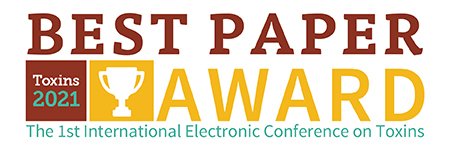
Best Poster Award
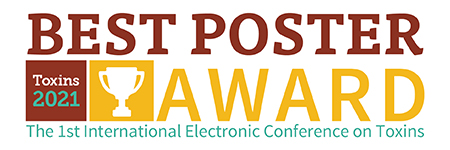
Best Oral Presentation Award

Applications and nominations will be assessed by the Scientific Committee. Winners will be announced online after the conference.
The Awards
Number of Awards Available: 2
The Best Paper Award will be presented to honor the 2 papers that is judged to make the most significant contribution to the conference. The award comprises 500 Swiss Francs and a certificate.Number of Awards Available: 2
The Best Poster Award has been established to recognize the scientific merit exhibited in poster presentation and preparation. We will select 2 winners and each will obtain 500 Swiss Francs and a certificate.Number of Awards Available: 1
As a sponsor, Toxins would like to grant an award for the best speaker of the live online session presented at the conference. The award comprises 1000 Swiss Francs and a certificate.Call for papers
The 1st International Electronic Conference on Toxins (IECT2021) will be held from 16 January 2021-31 January 2021. All proceedings will be held online at https://sciforum.net/conference/IECT2021
Topics are organized into six sessions:
- Novel plant, animal, insect and microbial toxins
- Mechanism of action and/or pathophysiology of toxins
- Use of toxins as tools for research, drug discovery, and therapeutics
- Impact of toxins on public health
- Impact of toxins on agriculture
- Evolution of toxins
The 1st International Electronic Conference on Toxins is sponsored by MDPI and the scientific journal Toxins (ISSN 2072-6651; Impact Factor: 3.531). The conference proceedings papers and presentations will be available on https://sciforum.net/conference/IECT2021 for discussion during 16 January 2021-31 January 2021 and will be published in journal Proceedings.
This conference will provide two Best Poster Awards, two Best Paper Award and one Best Oral Presentation Award . Each winner will receive bonus and a certificate.
IECT2021 offers you the opportunity to participate in this international, scholarly conference without having to consider travel expenses—all you need is your computer and access to the Internet. We would like to invite you to attend this conference; please present your latest work to be considered.
Abstracts (in English) should be submitted before 31 October 2020 online at https://www.sciforum.net/login. For accepted abstracts, the article, Conference Proceedings, Presentation Slides, Posters contains Video presentations, can be submitted by 20 December 2020 and will be available at https://sciforum.net/conference/IECT2021.
Paper Submission Guidelines
For information on the submission, peer-review, revision and acceptance of conference proceedings papers, please refer to the section “Instructions for Authors”.
Time Schedule
- Abstract Deadline: 6 November 2020
- Abstract Acceptance Notification Deadline: 20 November 2020
- Full Paper Submission Deadline: 20 December 2020
- Conference: 16–31 January 2021
Sessions
S2. Mechanism of action and/or pathophysiology of toxins
S3. Use of toxins as tools for research, drug discovery, and therapeutics
S4. Impact of toxins on public health
S5. Impact of toxins on agriculture
S6. Evolution of toxins
S7. Poster
Instructions for Authors
Submission
Submissions should be completed by authors online by registering with www.sciforum.net, and using the "New Submission" function once logged into the system.
- Scholars interested in participating in the conference can submit their abstract (about 200–300 words) online on this website until 6 November 2020.
- The Conference Committee will conduct a pre-evaluation based on the submitted abstract. All authors will be notified by 20 November 2020 about the acceptance of their abstract.
- If the abstract is accepted for this conference, the author is optional to submit a proceeding paper or a poster, optionally along with a PowerPoint and/or video, until 20 December 2020.
- The conference proceedings papers, posters and presentations will be available on https://sciforum.net/conference/IECT2020 for discussion during the time of the conference 16 -31 January 2021 and will be published in Journal Proceedings.
- The open access journal Toxins will also publish a Special Issue for the conference. After the conference, the authors can choose to submit an extended edition of their conference proceeding papers to this Special Issue. (The submission to the journal Special Issue is independent from the conference proceedings papers and will follow the usual process of the journal, including peer-review, APC, etc.).
Submission of Manuscripts
Submission: Manuscripts should be submitted online at www.sciforum.net/login by registering and logging in.
Accepted File Formats
- MS Word: Manuscripts prepared in Microsoft Word must be converted into a single file before submission. When preparing manuscripts in MS Word, the Electronic Conference on Surfaces, Coatings, and Interfaces Microsoft Word template file (see download below) must be used. Please do not insert any graphics (schemes, figures, etc.) into a movable frame that can superimpose upon the text and make the layout very difficult.
- LaTeX: Manuscripts prepared in LaTeX must be collated into one .ZIP folder (include all source files and images, so that the Conference Secretary can recompile the submitted PDF). When preparing manuscripts in LaTeX, please use the 1st Electronic Conference on Toxins and Applications LaTeX template files.
1st International Electronic Conference on Toxins Microsoft Word template file and LaTex template file
Microsoft Word template
LaTeX template
Manuscripts for the proceedings issue must have the following organization:
First page:
- Title
- Full author names
- Affiliations (including full postal address) and authors' e-mail addresses
- Abstract
- Keywords
- Introduction
- Methods
- Results and Discussion
- Conclusions
- (Acknowledgements)
- References
Manuscripts should be prepared in Microsoft Word or any other word processor and should be converted to PDF format before submission. The publication format will be PDF. The manuscript should be at least three pages (including figures, table,s and references). There is no page limit, although authors are asked to keep their papers as concise as possible.
Manuscript Preparation
Paper Format: A4 paper format, the printing area is 17.5 × 26.2 cm. The margins should be 1.75 cm on each side of the paper (top, bottom, left, and right sides).
- Formatting/Style: Papers should be prepared following the style of Toxins. The full titles and the cited papers must be given. Reference numbers should be placed in square brackets [ ], and placed before the punctuation; for example, [1,2], [3] or [1–3], and all the references should be listed separately and as the last section at the end of the manuscript.
- Author List and Affiliation Format: Authors' full first and last names must be given. Abbreviated middle names can be added. For papers written by various contributors a corresponding author must be designated. The PubMed/MEDLINE format is used for affiliations: complete street address information including city, zip code, state/province, country, and email address should be added. All authors who contributed significantly to the manuscript (including writing a section) should be listed on the first page of the manuscript, below the title of the article. Other parties, who provided only minor contributions, should be listed under Acknowledgments only. A minor contribution might be a discussion with the author, reading through the draft of the manuscript, or performing English corrections.
- Figures, Schemes, and Tables: Authors are encouraged to prepare figures and schemes in color. Full color graphics will be published free of charge. Figures and schemes must be numbered (Figure 1, Scheme I, Figure 2, Scheme II, etc.) and an explanatory caption must be added. Tables should be inserted into the main text, and numbers and titles for all tables supplied. All table columns should have an explanatory heading. Please supply legends for all figures, schemes, and tables. The legends should be prepared as a separate paragraph of the main text and placed in the main text before a table, a figure, or a scheme.
For further enquiries please contact us at iect2021@mdpi.com
Presentation Slides
Authors are encouraged to prepare a presentation in PowerPoint or similar software to be displayed online along with the manuscript. Slides, if available, will be displayed directly on the website using the proprietary slide viewer. Slides can be prepared in exactly the same method as for any traditional conference where research results are presented. Slides should be converted to PDF format before submission so that our process can easily and automatically convert them for online display.
Besides their active participation within the forum, authors are also encouraged to submit video presentations. If you are interested in submitting a video presentation, please contact the conference organizer at iect2021@mdpi.com to find out more about the procedure. This is an unique method of presenting your paper and discussing it with peers from all over the world. Make a difference and join us for this project!
Presentation of Posters
Authors that wish to present a poster only, i.e., without proceedings paper, can do so in Section I. Posters of this conference. Posters will be available on this conference website during and after the event. Like papers presented on the conference, participants will be able to ask questions and make comments about the posters. Posters that are submitted without a paper will not be included in the proceedings of the conference.
Posters should have the following information:
- Title (with authors and affiliations)
- Introduction/Objectives/Aims
- Methods
- Results
- Conclusion
- References
- Acknowledgments
- Contact information
For consideration for this award, posters should be accompanied by a three-minute video presentation. During the conference, the chair will be invited to judge the quality of the video presentations and posters. Presentations will be judged on how well they are able to summarize the content of the work and make the observer interested in viewing the poster. Posters will be judged on clarity quality of appearance.
Potential Conflicts of Interest
It is the authors' responsibility to identify and declare any personal circumstances or interests that may be perceived as inappropriately influencing the representation or interpretation of clinical research. If there is no conflict, please state here "The authors declare no conflict of interest." This should be conveyed in a separate "Conflict of Interest" statement preceding the "Acknowledgments" and "References" sections at the end of the manuscript. Financial support for the study must be fully disclosed under "Acknowledgments" section.
Copyright
MDPI, the publisher of the Sciforum.net platform, is an open access publisher. We believe that authors should retain the copyright to their scholarly works. Hence, by submitting a Communication paper to this conference, you retain the copyright of your paper, but you grant MDPI the non-exclusive right to publish this paper online on the Sciforum.net platform. This means you can easily submit your paper to any scientific journal at a later stage and transfer the copyright to its publisher (if required by that publisher).
S1. Novel plant, animal, insect and microbial toxins
S2. Mechanism of action and/or pathophysiology of toxins
S3. Use of toxins as tools for research, drug discovery, and therapeutics
S4. Impact of toxins on public health
S5. Impact of toxins on agriculture
S6. Evolution of toxins
Show all accepted abstracts (1) Hide accepted abstracts (1)
List of Accepted Abstracts (1) Toggle list
















_Kwok.png)




































